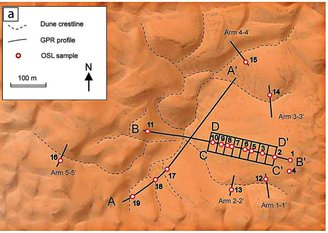A pioneering study recently published in the journal Scientific Reports presented a new sedimentary model. Star dunes, the world’s tallest, are finally recognized and studied in the rock recordThis is something that has not been done until now because geologists do not have a suitable model.
This gap left some of our planet’s largest and most spectacular aeolian landforms out of our planet’s geological history, according to the study. This research is the first to determine how long it takes for a star dune to form and explore its internal structure.
Star dunes, with their characteristic radiating arms (“star points”), are huge sand formations common in modern deserts, the “sand seas” of Africa, Arabia, China and North America, as well as on the planet Mars and the moon Titan. on Saturn.
Searching for Lala Lallia dune
Creating a model that can explain how such large structures form over time, Professors Geoff Duller and Charlie Bristow, from Aberystwyth and Birkbeck universities in London, traveled to the Lala Lallia star dune in the Erg Chebbi region in southeastern Morocco.
Researchers probed the interior of the star dune with ground-penetrating radar. “This not only enabled us to understand how this structure was formed, but also led to the development of an unprecedented model.”so geologists know better what to look for in the rock record To describe these incredible desert features,” says Bristow.
The approach, which also used luminescence dating, showed that the dune began forming between 12,900 and 11,700 years ago, during the Last Dryas event at the end of the last ice age on Earth. At that time, winds created a base of 30 meters and the dura stopped growing in the next 8 thousand years of 12 thousand years.
The importance of discovering the secrets of the dunes

The research concluded: Erg Chebb star dune has reached its current height of 100 meters and width of 700 meters over the last thousand yearsIt gradually migrates westward and its structure is affected by a change in wind direction.
According to Duller, “This research is actually about the missing dune: it has been a mystery why we could not see them in the geological record. And now only thanks to new technology can we begin to uncover their secrets,” says co-author Duller.
Using this data, the team was able to piece together the prevailing wind direction in the region at different times, shortly after the last ice age. With this it was possible to determine the speed at which the dune was formed and moved across the desert: about 50 centimeters per year.
Did you like the content? Therefore, stay updated with more studies on the geology of planet Earth on TecMundo and do not forget to share the article with your friends who love these topics. To the next one!
Source: Tec Mundo
I’m Blaine Morgan, an experienced journalist and writer with over 8 years of experience in the tech industry. My expertise lies in writing about technology news and trends, covering everything from cutting-edge gadgets to emerging software developments. I’ve written for several leading publications including Gadget Onus where I am an author.













